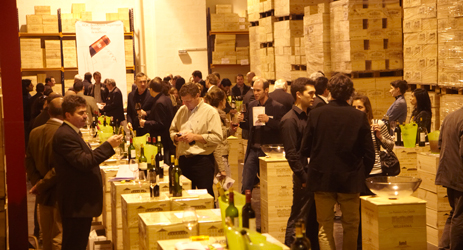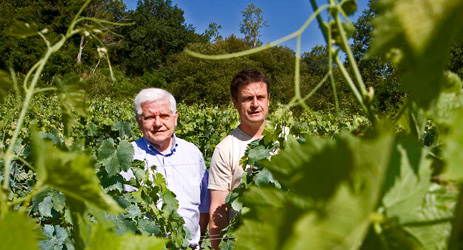The en primeur season kicks off on April 8th, ushering in a week-long round of tastings, lunches and dinners where buyers and critics from around the world will spit their way through hundreds of cask samples and cast their prognosis on the previous harvest. Invitations have been sent out for both the official tastings organised by the Union des Grands Cru de Bordeaux (UGC) and private ones from Biodyvin (biodynamic producers, who will host a conference at Chateau Pontet Canet at the start of the week) to select chateaux that choose to have their wines tasted only by direct appointment.

The tasting week (or two) is then followed by a lull where everyone heads home to discuss their findings, and the general market temperature is taken. And as soon as a chateau owner feels confident enough to make a decision, they will issue the price they want for their wine. Inevitably, once one price is out, a flurry of other chateaux will follow, all offering wines that can be paid for now, and that will be delivered in a year or two, after further barrel or bottle ageing.
Normally, by the time March rolls around, there is a quiet hum of anticipation. But this year the most notable thing, even at this late stage, is silence. Merchants will be coming to taste - Berry Bros alone are sending 30 members of their team to taste and assess, and there should be perhaps 4,500 wine professionals here in total - but there is a distinct nervousness at whether the market will care about the 2012 vintage of Bordeaux. The fact that several estates in Sauternes, and at least one in the Médoc, chose not to make wine in 2012 tells its own story, but it is always difficult to generalise in such a large region as Bordeaux, and there will undoubtedly be some excellent wines served up in early April.
Most merchants, however, are still focused on the 2010s that are universally recognised to be well-structured, powerful and long-lasting wines and yet were priced so highly (during the en primeur campaign of April 2011) that many are yet to sell through. A recent round of re-tastings from journalists and critics now the wines are in bottle has confirmed that their excellence might just justify the prices. 'They might have been a tough sell, but far worse is the thought that after the 2010s, we're just left with the 11s and 12s to play with,' confessed one merchant nervously to me last week.

It's worth remembering that, as Jean Charles Cazes of Lynch Bages says, 'most prophesies on how an en primeur campaign will go usually turn out to be totally wrong'. Clearly he’s right that it is way too early to think about pricing of the vintage before the wines have even been tasted, but it is always worthwhile getting an idea of what we’re looking at before even picking up a glass.
This means weather conditions, any particular differences between Left and Right banks, any markers to be looking out for in terms specific vintage issues. So in a hot year like 2003, even 2009 to a certain extent, wine generally have low acidity and high pH, something that can encourage over-ripe, blowsy flavours, or even the development of barnyard aromas characteristic of a 'brett' infection (acidity offers some protection against this). In a rainy year, rot in the grapes can lead to the appearance of geosmin - an earthy, musty smell. And if grapes avoid rot but are picked too early before fully ripe, they can still contain detectable levels of IBMP, a molecule that has a distinctive green pepper aroma. If you know the potential pitfalls, you can be alert to them while tasting. You're not going to hear about them in the official UGC press releases, so it's worth swotting up a little before heading over here, or before making a purchase with your wine merchant.
I have begun tasting some of the 2012 reds and whites already, and have found some interesting wines. 2012 saw an extreme period of drought in August and early September, but bookended by a wet spring and a wet end of season. Vintages like this are where soil types really come into play, particularly in terms of their ability to moderate the supply of water – draining it when necessary, and retaining it when things get too dry. White grapes tend not to like water stress as much as reds, which is why limestone is such an ideal soil, unlike clay or gravel which can dry out in hot periods. This matters because a white grape that doesn’t suffer too much water stress will keep its acidity levels fairly high – and in sauvignon blanc in particular, a good level of acidity is important for maintaining the purity of the aromas. This is potentially good news for the white wines of Entre deux Mers and the Cotes de Bordeaux, where there are plenty of limestone-clay soils – and generally the whites seem to have done pretty well this year. Equally merlot on clay soils seem to have produced the best of the reds – good news for the Right Bank.

It’s worth also sounding out the opinion of consultant oenologists, as they tend to have wide experience over a number of appellations and estates, and inevitably have less bias than individual chateaux. These guys often assist at more vinifications over the course of a single year than a winemaker at one estate would do in his whole career.
Antoine Medeville, of Oenoconseil, says of the Médoc, 'Spring and early summer we feared the worst, and local conditions saw oidium and mildew develop, which had consequences for flowering. But the hot and dry August and September allowed the gaps in maturity to be less obvious, and to limit the loss of yield. Harvest went well, although later ripening cabernets were brought in under rainy skies... 2012, even if will not be at the level of 2009 or 2010, will be a good quality one.’
As Medeville says, the rains that came at the end of September were particularly difficult, as it was too late to spray the crops to guard against rot. Most winemakers escaped serious problems (the whites were picked before the rains, as were many merlot grapes), but others will have found problems with either a vegetal character from picking under pressure, or will have grappled with the tell-tale tastes of rot. Here selection and blending will have been vital.
Edouard Massie, an oenologist in the Graves region, sums it up by saying, 'you had to not only be a good vigneron, but also a workaholic to protect your vines against all the pressures that it came under this year.’
Some, undoubtedly, will have managed just that. It’s going to be interesting to see which ones…

Columnist Introduction
Jane Anson is Bordeaux correspondent for Decanter, and has lived in the region since 2003. She is author of Bordeaux Legends, a history of the First Growth wines (October 2012 Editions de la Martiniere), the Bordeaux and Southwest France author of The Wine Opus and 1000 Great Wines That Won’t Cost A Fortune (both Dorling Kindersley, 2010 and 2011). Anson is contributing writer of the Michelin Green Guide to the Wine Regions of France (March 2010, Michelin Publications), and writes a monthly wine column for the South China Morning Post in Hong Kong, where she lived from 1994 to 1997. Accredited wine teacher at the Bordeaux Ecole du Vin, with a Masters in publishing from University College London.
Click here to read all articles by Jane Anson>>
All rights reserved by Future plc. No part of this publication may be reproduced, distributed or transmitted in any form or by any means without the prior written permission of Decanter.
Only Official Media Partners (see About us) of DecanterChina.com may republish part of the content from the site without prior permission under strict Terms & Conditions. Contact china@decanter.com to learn about how to become an Official Media Partner of DecanterChina.com.











Comments
Submit